
Arc Pigs contain internal baffles (I.e., rubber walls) to direct the flow of cooling air. The original Pigs used edge-grip baffles, like this.

The edge-grip baffles work fine, but they contain buried metal strips. We don't like metal so close to the coupling coil, so we have switched to a new baffle.
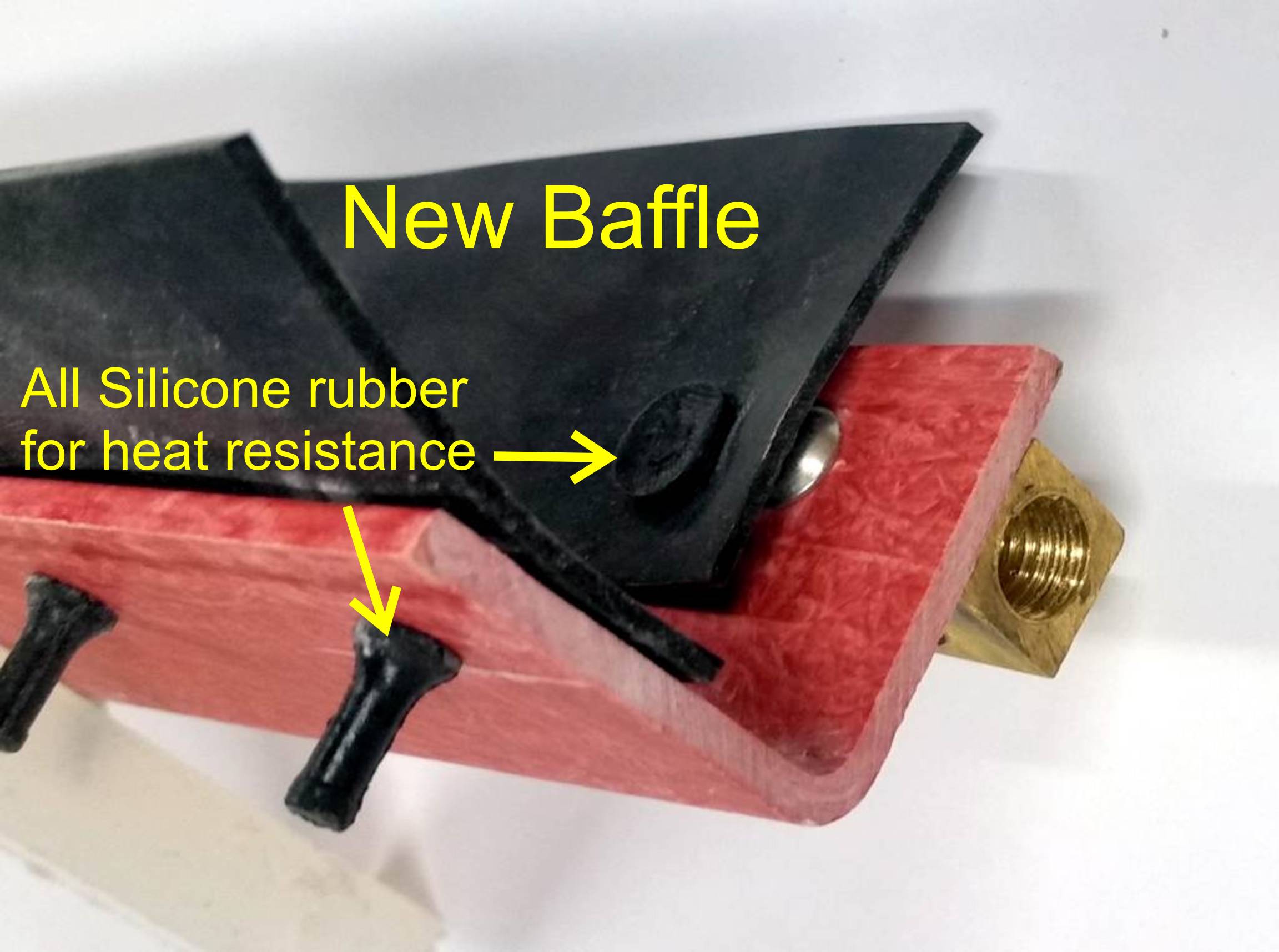
The new baffles are more labor-intensive, and it took us a while to figure out how to mount them without metal or nylon fasteners. (Nylon would be fine, until you overheat the coupling coil.) We are still shipping Pigs that use a similar, all-silicone scheme, with oozed-in-place silicone rubber rivets. It works fine, but is not as pretty. You can see it in the couple-coil pictures below.
Nothing. You may ignore it.
Since Arc Pigs were first introduced (in 2012) they have always used a 16-turn coupling-coil secondary. (The part that transmits the HF spark into your torch cable.)
Sixteen turns gave us a nice balance between spark voltage and weld current, with a spark voltage about 25KV at the output stud, and a maximum weld current of 250 amps. (At 60% duty.)

But you don't care about spark voltage at the output stud, you care about spark voltage at your torch, down at the other end of your torch cable. This wouldn't matter, we thought, because your torch cable would be short (8-ft) like we suggested. If you want to work farther away, we suggest you keep your torch cable short and just lengthen the cable to your Pig.
But nobody takes our suggestions. Professional welders almost invariably use their Pigs with 25-ft torch cables. We noticed this, but didn't think much of it.
We had our head up our ass.
A long torch cable is a capacitor, which soaks up the Pig's HF spark. For example, a 25-ft torch cable reduces the HF spark voltage from 25KV to about 10KV.
Here is the fun part: We can get that same 10KV spark to the end of your 25-ft torch cable, with an 11-turn secondary.
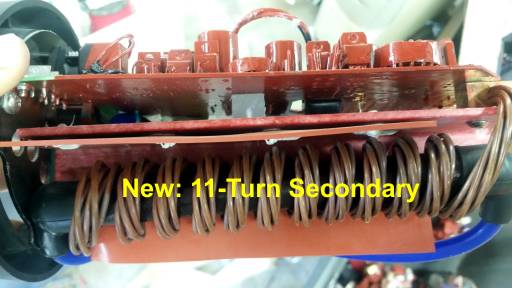
Reducing the secondary turns (from 16 to 11) does not change spark energy, it just changes some of the spark voltage into spark current. (Not to be confused with weld current.) The current actually does a better job at filling up the capacitance of your torch cable, helping propogate the spark voltage to your torch.
So we reduced Arc Pig secondary turns from 16 to 11.
The HF spark now starts with lower voltage, but travels down your cable better. The net effect is (virtually) no change, if your torch cable is 12 feet or longer.
The downside is, if your torch cable is less than twelve feet, your HF spark won't jump as far, though it will have the same energy and ignition power. We loved the long, dramatic spark, but it was mostly just for show, since it jumped farther than you could use for welding.The upside, and it's a big one, is the Pig can now handle more weld current. In fact, weld-current capacity scales as almost the inverse square of the number of secondary turns. So the Arc Pig's weld current capacity has been materially increased.
We haven't changed our current-rating label yet, because that requires formal testing, which is a pain. Also, we like the idea of delivering more than we promise.
Now it is even harder to overheat your Pig.
If you use a short torch cable, the HF spark won't jump quite as far, but has the same energy.
If you use a long torch cable, the spark at your torch will look the same, because it is the same.
For geeks, the Pig's output frequency is dominated by other factors, and has not materially changed.
5/4/2016 UPDATE: We found the problem, and fixed it on all new pigs. We will be mailing a five-minue fix to all affected Pig owners.
The problem happens when one trigger wire is wrapped around the torch cable, but the other is not.
The trigger needs two wires. If one trigger wire is wrapped around the torch cable, but the other is not, the combination creates a transformer (the torch cable is the primary; the trigger wire is the secondary) which transfers HF spark energy from the torch cable to the trigger circuit. The HF energy slowly erodes the trigger isolation transformer, and after a few hours or days of continuous fire it will fail.
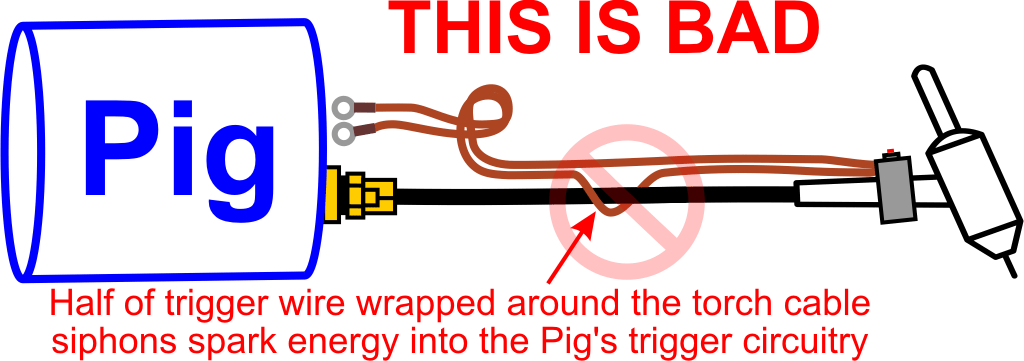
Wrapping both trigger wires around the cable is no problem, which is why it took us so long to figure this out.
The fix is to straighten out the trigger wires, OR connect a 5-nf, 630V capacitor across the trigger terminals.
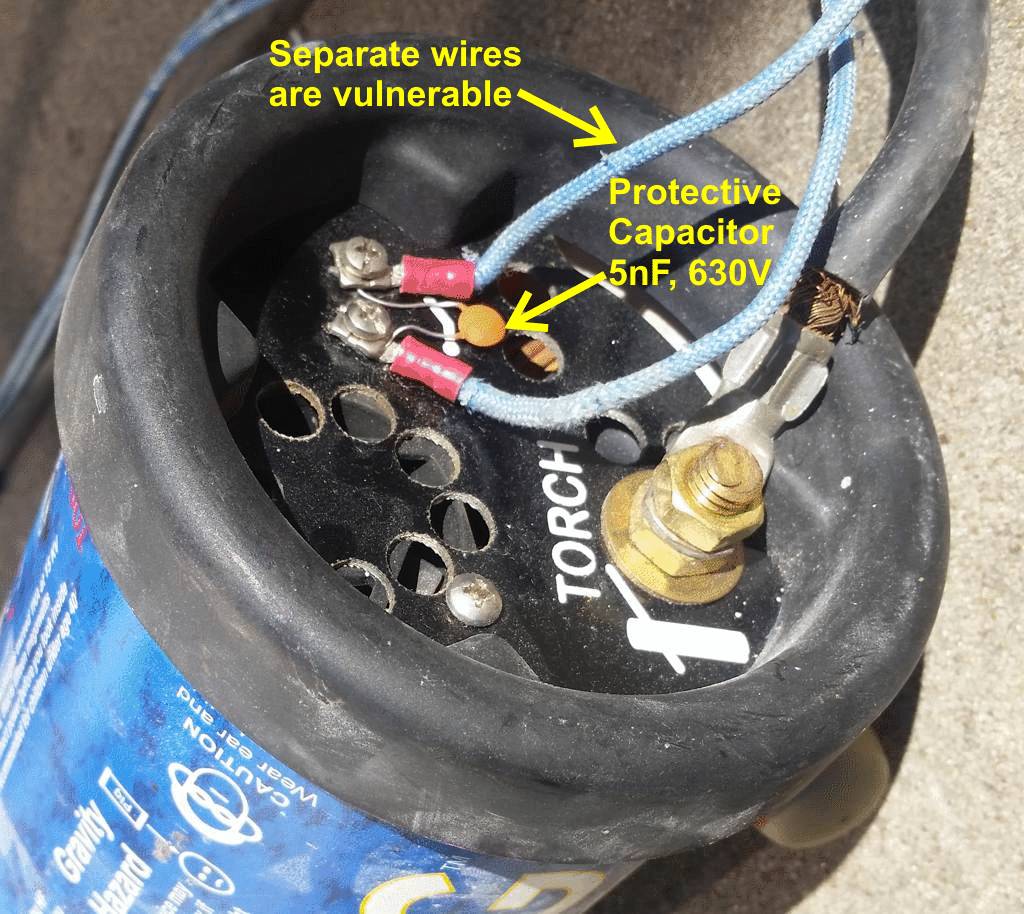
We will give the capacitors away for free.
Even if you install the protective capacitor, you should still straighten out your trigger wire, so it will not siphon off spark energy.
Our original trigger wires were coaxial, which is immune to this problem. (If one coaxial conductor wraps around the cable, the other necessarily does too.
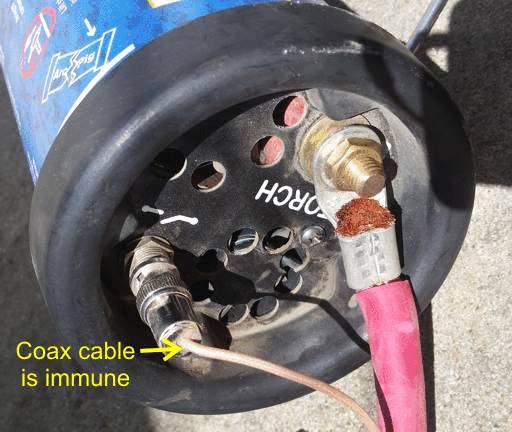
ORIGINAL POST
Some Pigs are getting stuck in the on position (I.e., continuous fire) even if the trigger is not pulled.
The incidence is low, a few percent, but we are working on it.
The problem is this trigger isolation transformer, which is shorting out.
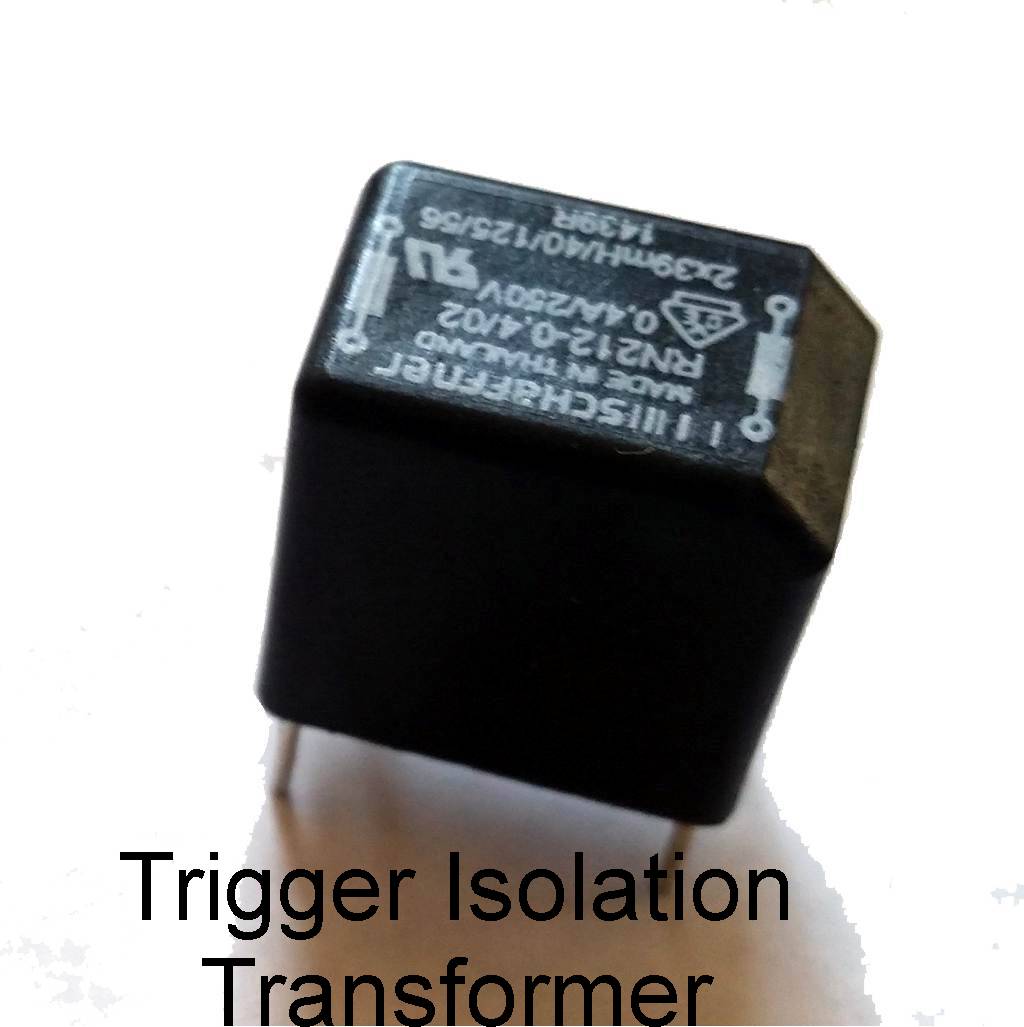

We confess, we are surprised. Isolation transformers are passive components and should not fail, especially when they get virtually no current, as ours does. We had even gone the extra mile, potting the entire transformer in epoxy.
We thought our potting might be the problem. Maybe the epoxy was too stiff, and somehow broke the transformer's ferrite core. So we melted down a failed transformer and pulled out its ferrite core.
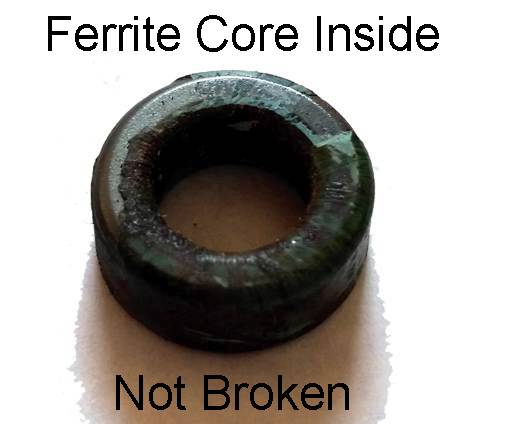
The ferrite is intact, so our potting is not the problem. Our best theory is, some of the transformers got too hot during soldering, and melted their internal insulation.
It's just a theory. We cannot inspect the solder connections, because WE POTTED THE ISOLATION TRANSFORMERS IN FREAKING EPOXY.
We don't like our hot-solder theory, because the failure never happens here, right after the unit is soldered. It only happens in the field, usually after extended use.
Another theory is the isolation transformers are getting zapped by HF, when the torch cable and trigger wire are both damaged. We like that theory even less, because we expected the trigger to get zapped, so WE POTTED THE ISOLATION TRANSFORMER IN FREAKING EPOXY. During testing, we connect the Pig's HF output directly to its trigger input for prolonged periods, and the isolation has never failed.
So, for the moment, it's a mystery. We will try to cut down on solder heat, and see if that helps.
On the bright side, the isolation transformer now comes pre-potted from the factory. Perhaps someone else experienced this problem, and the transformer manufacturer fixed it.
If anyone has an idea, please use the contact page to drop us a note.
Our apologies for anyone affected, and we will of course fix your Pig for free. We have never denied any warranty claim on any Arc Pig for any reason.
We gave up on the coaxial trigger wire. It was the toughest wire we could find, but splicing it was just too difficult. New Pigs will come equipped with the simplest trigger connection we could think of: Two screw studs.
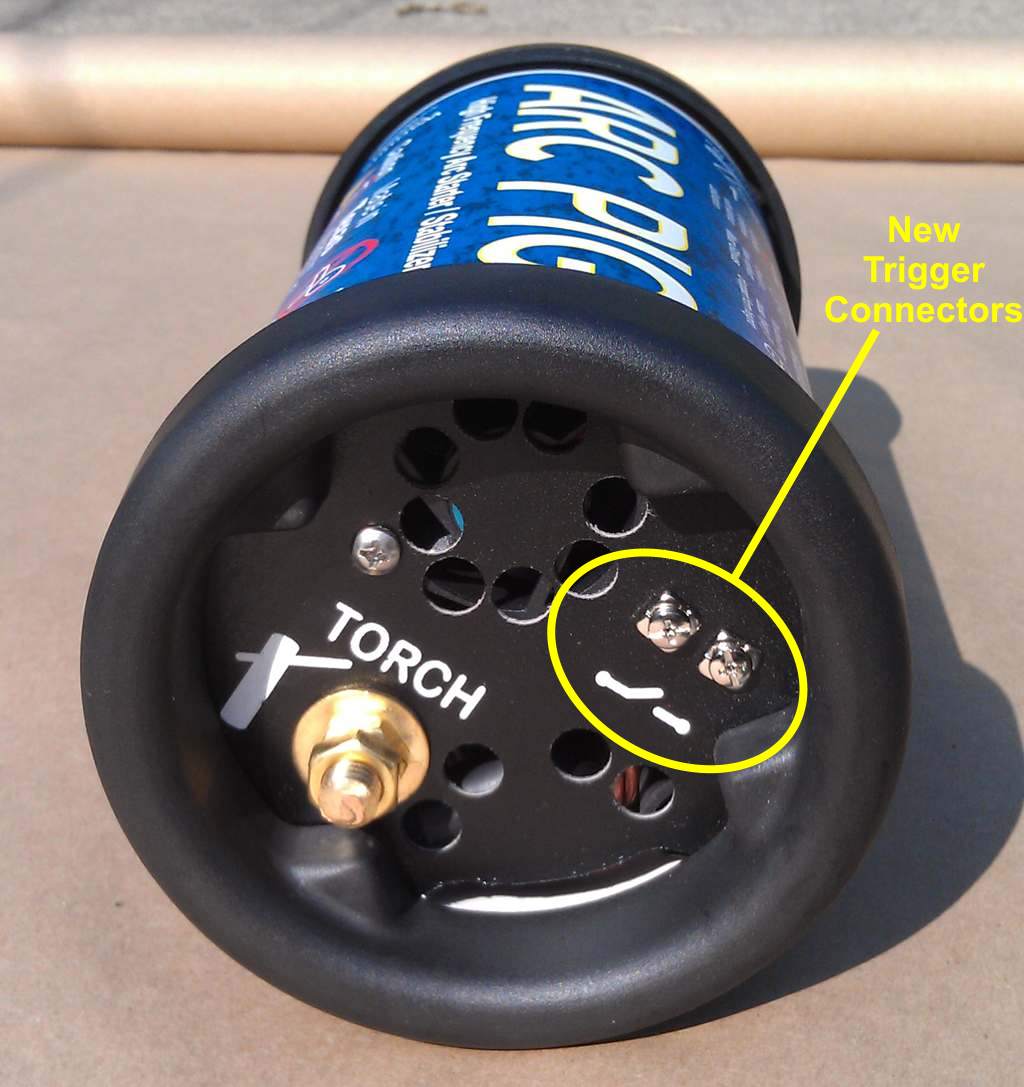
The new scheme lets you use any trigger wire. We suggest 18AWG high-temp appliance wire and fork terminals. (That is what we give you free with your purchase.)
Nothing. Current users can ignore it. New users will find their life a little simpler.
Recently, a large welding shop reported some failures among their twenty Arc Pigs. We are not used to Pigs failing, so we may have used some bad language. (Not at the customer, who was nice to a fault.) When we got the failed units into our shop, we found some silicone insulation delaminated. Weld smoke sifted into the gap and allowed high-voltage tracking, which eventually grew into a high-voltage short.
Weld smoke. Should our customer have used his Pigs in cleaner air?
Hell no. He should use them however he damn well pleases and his Arc Pigs should suck it up without complaint. So he gets all his Pigs replaced or upgraded free, and an extra Pig thrown in for his trouble. Look for some reconditioned Pigs to be available soon at a modest discount.
We fixed this design weakness by lifting the high-voltage connection off the PC board. (See pics below.)
If you have a problem, call us. We have never denied any warranty claim for any reason, no matter when you bought your Pig, or where.
In the meantime, we suggest you insulate the high-voltage connection with silicone rubber, automotive undercoat, or Flex-Seal around the spot shown in the picture. Your Pig may look different, so find the rounded-disk HV capacitor near the spark gap, and coat everything within an inch. (The PC board underside too.) But don't get any on the fan blades, because an unbalance will quickly destroy the fan bearing.
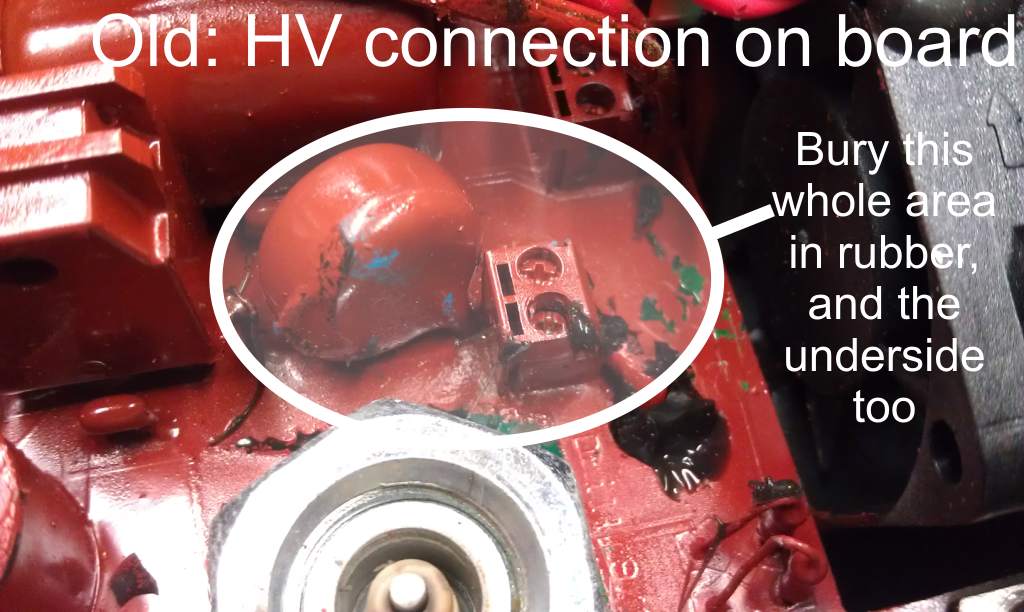
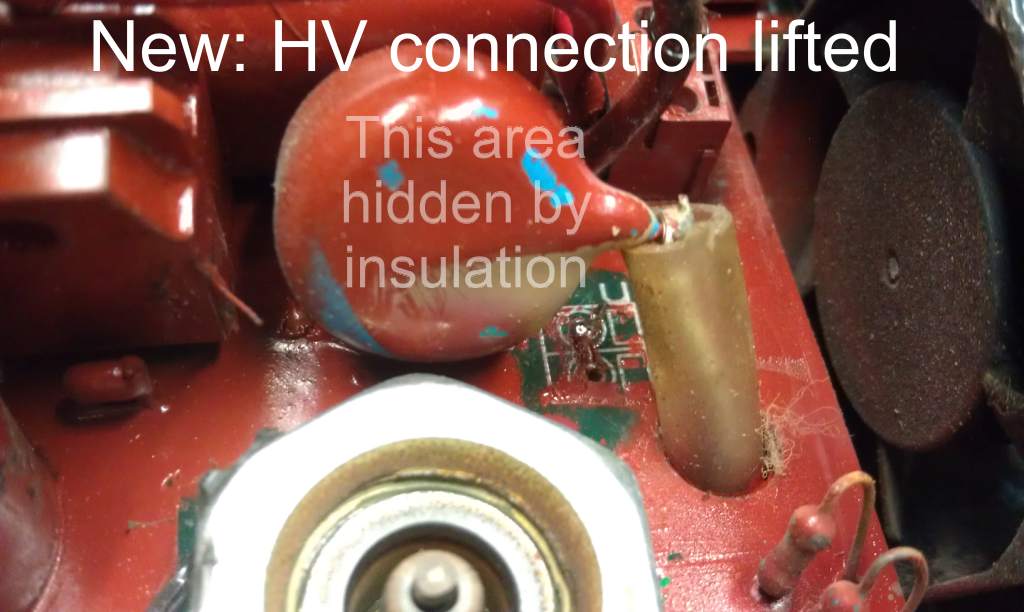
Otherwise your worries about weld smoke should be confined to your own lungs, because Pigs can take it. Here is an Arc Pig operating with its cover off (don't do that) under what we judge to be a weld-smoke worst-case scenario.
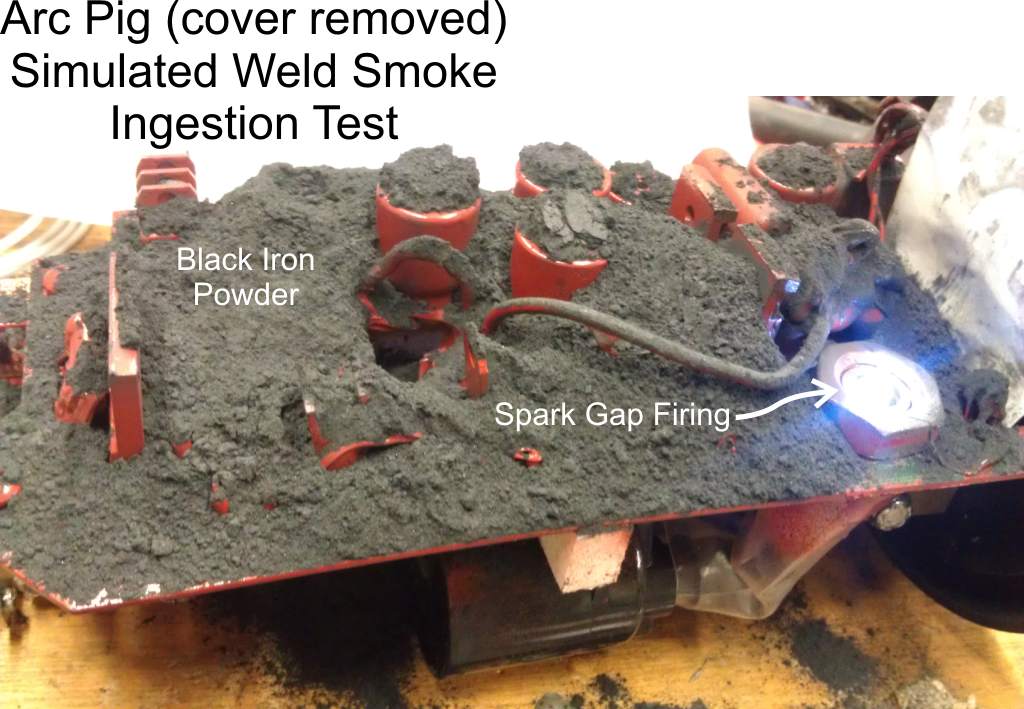
In case you are wondering, the spark gap burns off small amounts of iron powder. If you clog the spark gap with more iron than it can burn, the Arc Pig detects the short-circuit and beeps until you clean the gap.
We have no reports of the old insulation failing, but our in-house endurance tests made us worry about one lot of silicone tube insulation. The new insulation comes from a different supplier.

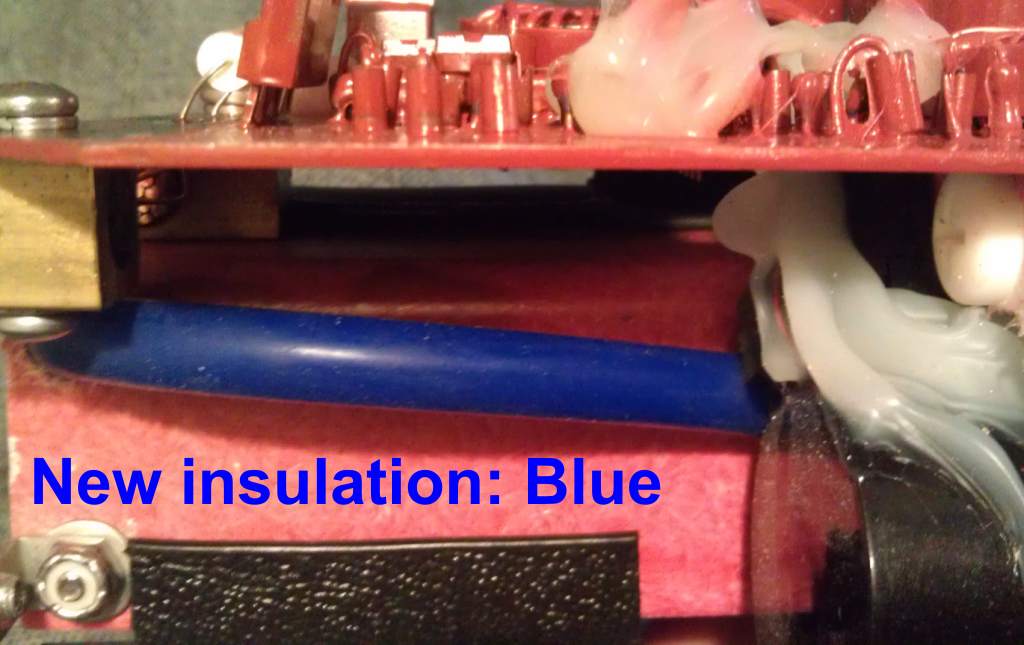
Probably nothing, because we don't think you can heat the old insulation enough to cause a problem. If this insulation does not age gracefully, we will extend warranty coverage for it.
With that said, IF you run your Pig close to its 250-amp duty cycle, AND your Pig has the translucent primary lead insulation that looks like the picture, we suggest you send it to us for a free upgrade to the new insulation. We will turn it around quickly.
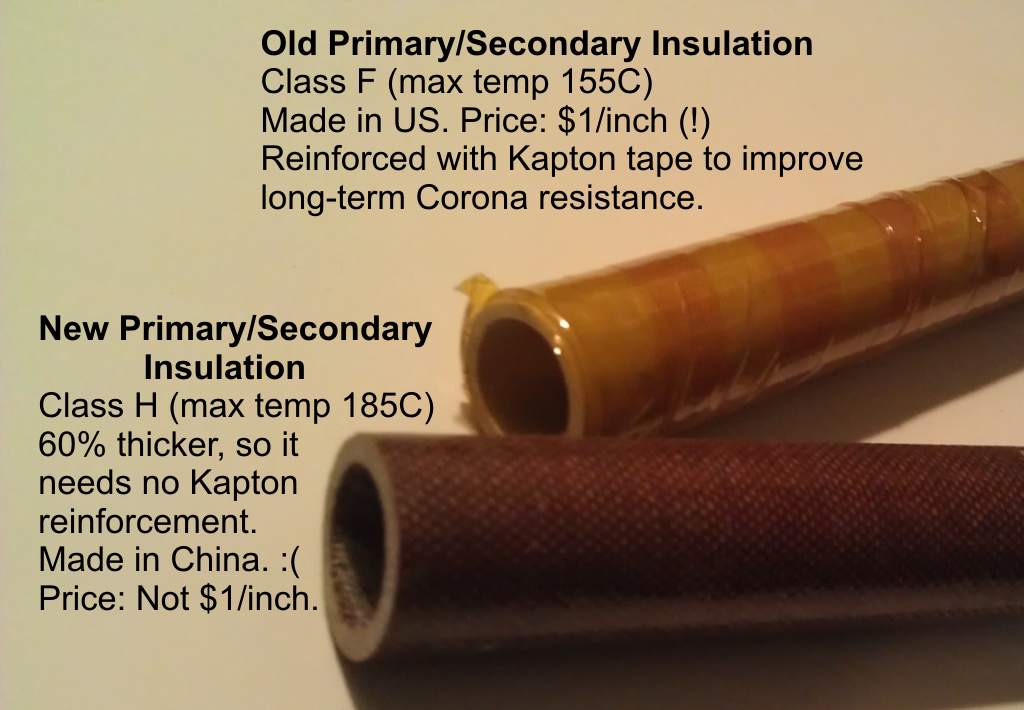
Made in China. Sigh. Are we willing to pay twenty percent more to get these from a US supplier? Oh hell yeah. Were we willing to pay five hundred percent more? Oh hell no.
Nothing.
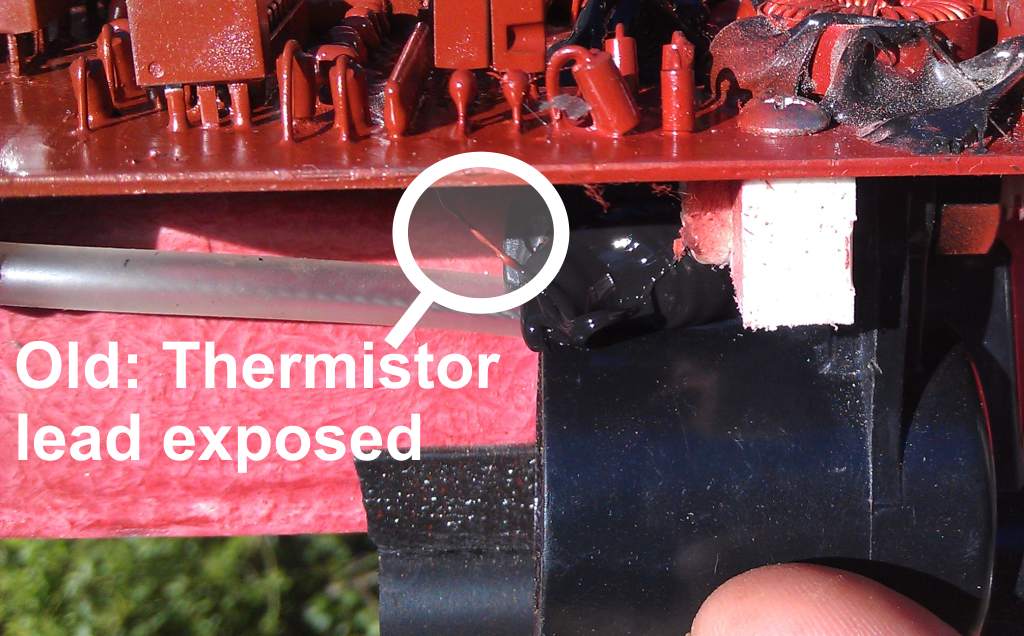

When the thermistor lead is exposed to the flow of cooling air, the thermistor reads low. In theory the ignition coil could overheat.
Probably nothing, because we don't think you can overheat your coil, even at extreme duty cycles.
If you operate your Pig at extreme duty cycles (more than fifteen continuous minutes of continuous fire) then we suggest you glob some silicone rubber around the thermistor lead, like in the picture. If you send it to us we will do it for you free, but doing it yourself will be less hassle than packing and shipping.
The old method has worked well, but requires full weld current to pass through three separate connections on both input and output, for a total of six internal power connections.
The new method presses the brass stud directly against the internal copper cable, for a single connection on input and one on output. Thus we have reduced internal power connections from six to two.
The new method is similar to that used to connect the power line to your house. It is proven reliable even for metals much more dissimilar than copper and brass, and handles high current.

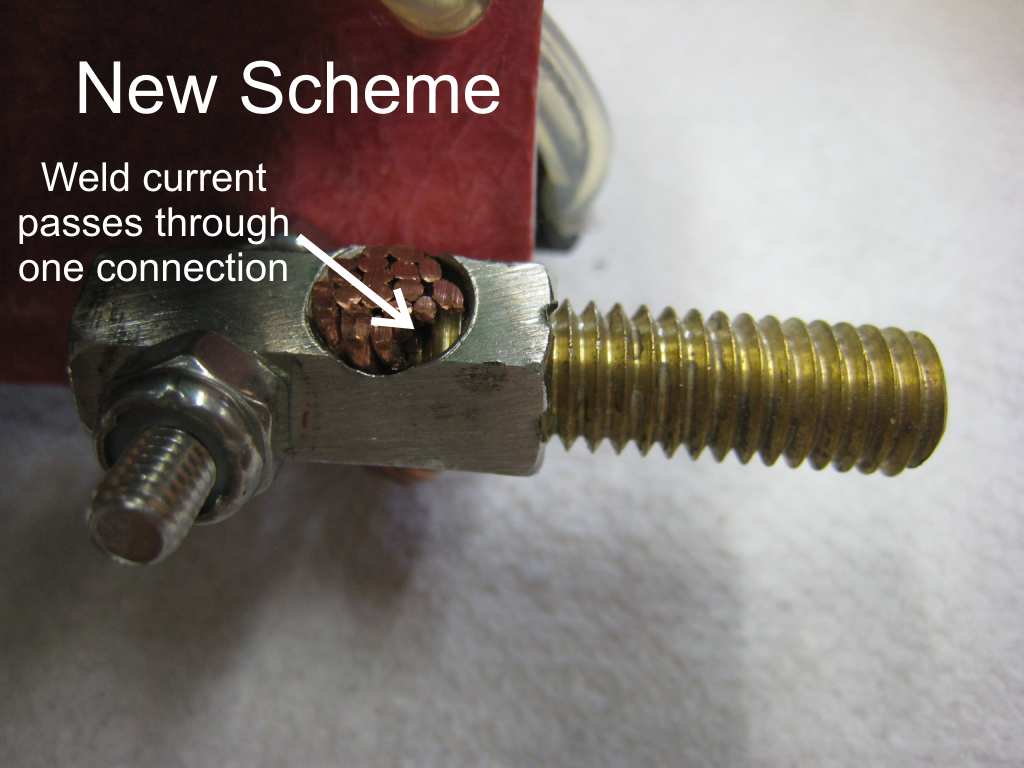
That stainless-steel part gave us some trouble. We were thinking about conductivity, when we should have been thinking about friction, and stainless steel is a bitch to machine, even after we figured out the bacon-grease trick. In future models, some of the stainless parts will be replaced by brass.
We have no reports of the old scheme failing.
Nothing. You may ignore it. We think the only real chance for failure is if you somehow manage to loosen the brass stud. We don't think that will happen, because we crank the stud down pretty tight. But if the stud does loosen, it can be retightened just like any other stud. (Jam two nuts together to grip the threads.)
The old blower works fine, but would be hard for users to replace because it is an odd shape. The new fan is a standard, 40mm form factor commonly used on computer graphics cards.
The new fan produces the same airflow, as measured in-Pig by our high-tech, stopwatch-and-garbage-bag technique.
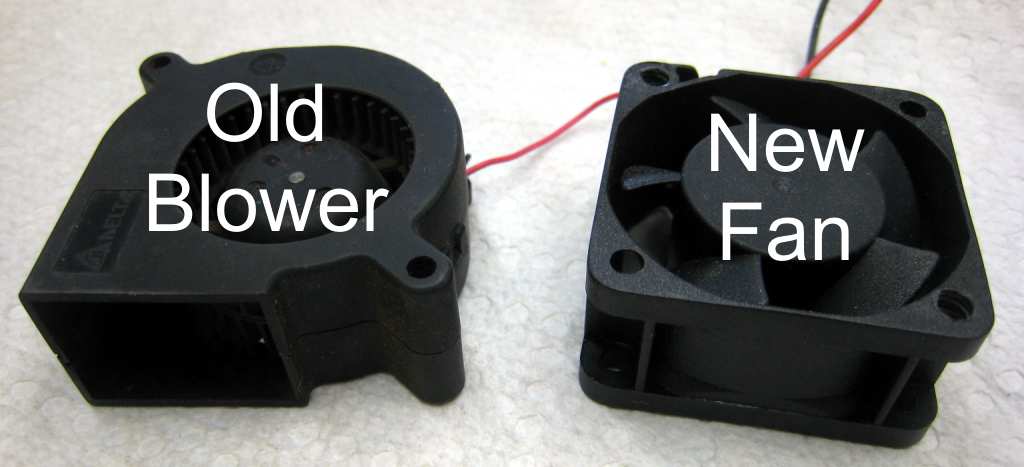
We have no reports of the old blowers failing. The new fan is made by a reputable company (Orion) and promises an expected life of 50,000 hours.
Nothing. You may ignore it. If your fan ever fails, now it will be easier to find a replacement.
Up to now, the Arc Pig warranty has excluded various forms of abuse, for the obvious reason.
But now we have two years experience with Arc Pigs in the field. Almost without exception our customers have proved reasonable, and not opportunistic looters. We are pleased and, we confess, a little surprised.
So we trust you with a better warranty. As of now, Arc Pigs are covered for one year for failure from any cause. If your Pig stops working because it rolled off your truck and you dragged it twenty miles, we will fix it. Provided you ship us a recognizable carcass at your expense.
We are imposing a few caveats, of course. See the details on the inside cover of the Pig Owner's Manual
Our main request is, if you break your Pig, please tell us the truth.
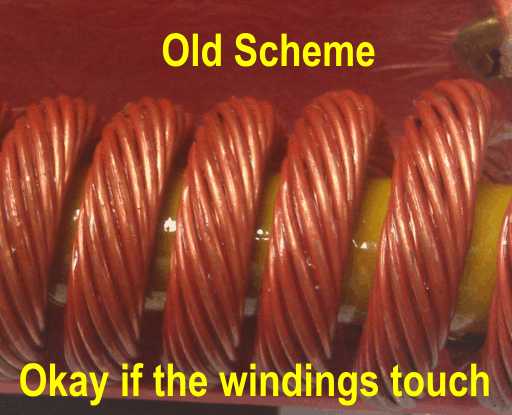
The coupling-coil windings must be isolated, because when the Pig fires, each turn generates roughly 1kV. Isolation is not needed for a fresh-made Pig, because its windings are physically separated. However, in the field, a sharp impact could drive the windings together.
We no longer varnish the coil windings. Instead we maintain their separation with a bead of silicone rubber.
We have no reports of the old scheme (varnish) failing, but we judge the new scheme to be slightly more reliable. If the coils windings are driven forcefully together, the impact could damage electrical varnish. Silicone rubber is more resilient, and will compress then spring back to reestablish winding separation.
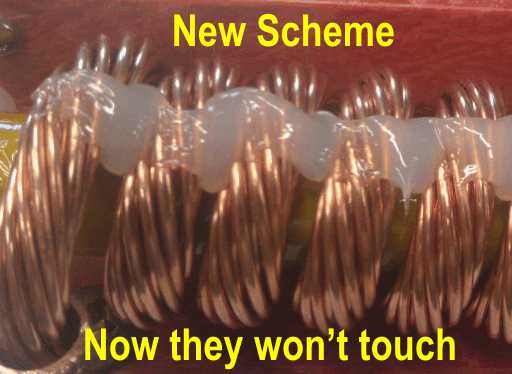
Nothing. You may ignore it.
The coupling-coil primary carries electric pulses, powerful but brief. Those pulses couple into your weld cables magnetically, to induce high-voltage, low-current sparks.
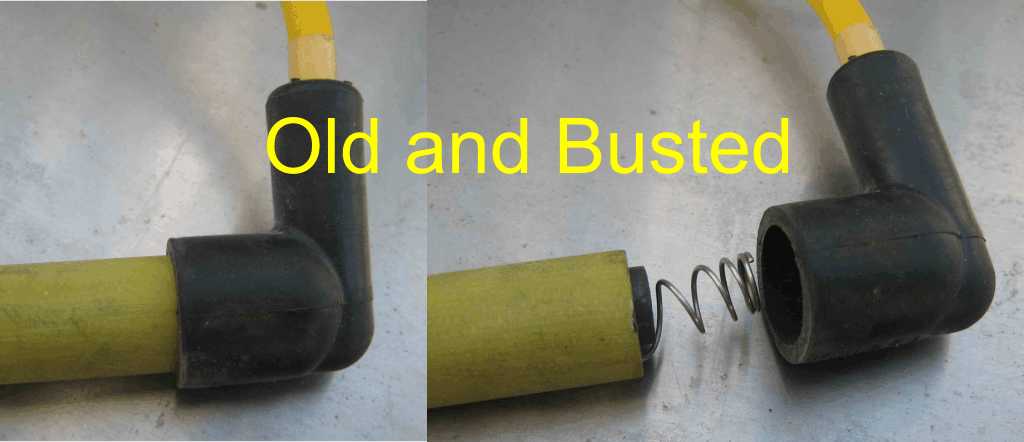
The coupling coil has now been simplified. The old design included two spring connectors, which made it easier to inspect the ferrite rod. The ferrite rod is seven inches long, and runs through the coupling coil. The rod is well protected, but brittle, so it could break, if your Pig is dropped from higher than three feet. Breaking the rod causes weak spark.
The spring connectors are now history, simplifying the primary circuit to a single contiguous wire. This removes two points of failure. The downside is, the ferrite rod is now more difficult to inspect. Also our big pile of now-useless springs and rubber boots.
We did it for the obvious reasons. Two years of experience have revealed that inspecting the ferrite rod is not important, but reliable electrical connections are.
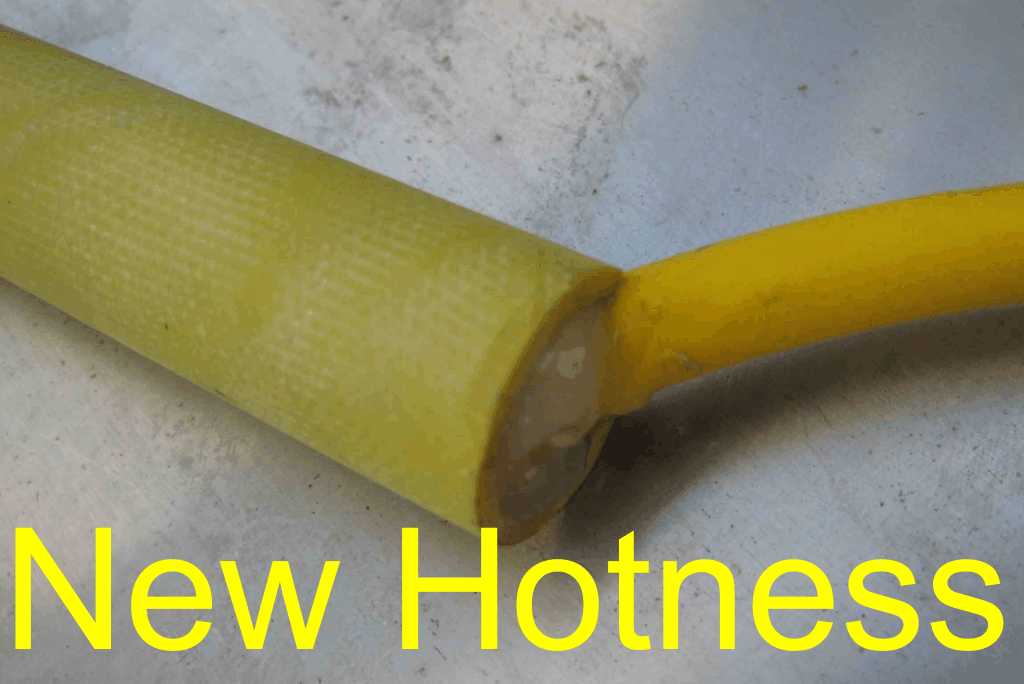
The ferrite rod does not need inspecting because it does not break. The rod's shock cushions (which consume approximately ten percent of the Pig's production cost) have proved adequate for field conditions. Hoorah. (Be advised that your rod will break, if you drop your Pig from much higher than three feet.)
Nor do we have reports of failures of the old spring connectors. However we have failed them in our shop. As we experiment, we reassemble our prototypes many times, and sometimes we plug the springs in carelessly. If they do not make good contact, the springs are quickly destroyed by electrical arcing. This causes the Pig to stop firing, and beep until we release the trigger.Nothing. You may ignore it.
Copyright 2012-2014 Arc Pig Co. Original web design by Codeticians, authors of AngelTrack Ambulance Software.